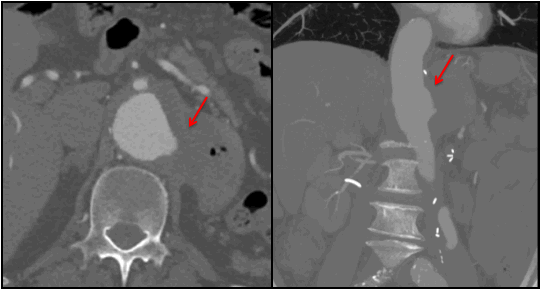71-Year-Old Male with Hematemesis and Prior Open Paravisceral Aortic Repair
Aleem K. Mirza, MD, Shuja Fahad, MBBS, Manju Kalra, MBBS.
Mayo Clinic, Rochester, MN, USA.
DEMOGRAPHICS: 71-year-old male with hematemesis was transferred emergently to our institution.
HISTORY: The patient had suffered two episodes of syncope within the preceding month, the second associated with large-volume hematemesis. Esophagoduodenoscopy demonstrated a pulsatile mass at the lesser gastric curve, without active hemorrhage. Past history included paravisceral aortic aneurysm repair through a retroperitoneal approach 4 years prior, with a long, beveled proximal anastomosis , incorporating the celiac axis (CA) and superior mesenteric artery (SMA). Two right renal arteries (RRAs) were incorporated with a separate patch and the atrophic left kidney was not revascularized. The patient had undergone no imaging follow -up. Computed tomography angiography (CTA) demonstrated disruption of the proximal anastomosis with a large mouthed pseudoaneurysm and no plane between the aorta and stomach (Figure 1). There was extreme tortuosity the distal aortic graft and 3 cm common iliac artery aneurysms. Medical co-morbidities included hypertension, hyperlipidemia and extensive smoking history.
PLAN: The patient was medically optimized in the ICU over 24 hours and then taken to the operating room. Through a 6th interspace posterolateral thoractomy a trifurcated Dacron graft was anastomosed to the descending thoracic aorta. Through a midline laparotomy, the SMA, common hepatic artery (CHA) and RRAs were dissected without disturbing the prior operative field. The limbs of the trifurcated graft were tunneled through the diaphragmatic hiatus travelling to the right, anterior of the esophagus. They were anastomosed sequentially end-to-end to the 2 RRAs spatulated together and end-to-side to the SMA and CHA, which were ligated proximally. With thoracic and abdominal aortic control the aorto-gastric fistula was taken down with partial gastrectomy and the upper abdominal graft was replaced in-situ with Rifampin-soaked Dacron, followed by omental wrap of the entire reconstruction. Postoperative course was uneventful and he was discharged on day 11. Cultures grew S. mitis and Actinomyces. He received a 6 weeks of intravenous antibiotics and remains on chronic oral supression.
DISCUSSION: The extra-anatomic antegrade visceral debranching in a clean field, allowed for minimal end-organ warm-ischemia time prior to aortogastric fistula takedown. In-situ reconstruction of the aorta was the most reasonable option utilizing Rifampin-soaked Dacron wrapped in omentum. 
Back to 2019 Abstracts
